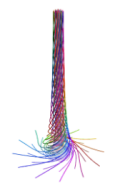|
The Big Splat, or How Our Moon
Came to Be ... ...
is an intriguing celestial whodunit that traces the long story of humanity's fascination with the
Moon. What is it? How did it get there? Beginning in the
nineteenth century, the question of the Moon's origin
moved from the realm of speculation to evidence-based
theory. Three theories, in fact, all based on
(somewhat) sound scientific principles. The leading
scientific mission of the Apollo missions was to
break this intellectual logjam and tell how the Moon
really came to be.
But a funny thing happened when
Apollo went to the Moon. None of the
theories could successfully account for the chemical
composition of the Moon rocks and the Moon's geological
history. All three theories turned out to be impostors! Instead, planetary scientists now
accept a fourth theory as the most likely explanation.
(SPOILER ALERT! Skip the next paragraph if you
want to find out the answer from the book.)
Earth
actually collided with another planet, which I call Theia, when our planet was about 1 percent of its
present age. This was the most cataclysmic event in
Earth's history, trillions of times bigger than the
meteorite impact that killed the dinosaurs. It nearly
destroyed our planet, but instead it gave us a new
satellite, which formed out of the debris of the
collision. The giant impact theory (or "Big Splat," as I
call it) actually explains much more than the origin of
the Moon; it is part of a whole new understanding of the
formation of planetary systems. To quote Nature
magazine: "Mackenzie's book emphasizes the fact that
impacts have been the primary creative and destructive
process throughout the history of the Solar System."
The Big Splat
tells the
fascinating story of how real science is done, how
scientists make mistakes and don't always find what they
expect to. If you've ever wondered what we learned from the Apollo missions, you
must read this book! |

![]()

